As of January 2019, it is estimated that there are 16.9 million cancer survivors in the United States. This represents 5.0% of the population. And, in 2019 alone, 1.7 million new cancer cases were diagnosed in the United States. It’s a sad truth that the likelihood of an esthetician encountering a client that either has a history of cancer treatment, is in the process of undergoing treatment or is recovering from treatment is high. Oncology facial treatments is a form of esthetic treatment that is meant to complement medical oncology treatment, addressing unique skin concerns that can arise from oncology treatment while also offering important integrative therapy to help alleviate stress and anxiety associated with combatting cancer.
Certification in Oncology Facial Treatments has become more and more available throughout the United States, through organizations such as Oncology Training International. Becoming certified in oncology facial treatments and incorporating it into a practice can be an enormously rewarding and enriching experience for the esthetician, knowing that they are addressing a demographic that can derive truly life-changing benefits from their services.
Here is an overview of what a oncology facial treatment entails, as well as ingredients and information the esthetician will need to incorporate into their practice in order to become a certified practitioner.
What is Oncology Facial Treatments
Oncology facial care is a practice that involves post-graduate education to learn how to perform facial and body treatments that are safe for a client that is undergoing or recovering from cancer treatment. This includes selecting the right ingredients that will not be contraindicative to any of the medications or treatments, as well as understanding the various forms of cancer treatment and side effects and how they can be ameliorated through esthetic services
Oncology facial care complements medical oncology by implementing integrative therapies such as massage and aromatherapy as well as cosmetic and skin care services to help provide physical as well as psychological benefits. This is an intensive area of study because each client has unique circumstances: individualized cancer treatments as well are resulting concerns such as heightened sensitivity or prosthesis. Estheticians trained in oncology facial treatments need to have intensive training in medical oncology treatments as well as possible side effects in order to properly and safely provide services to an oncology patient. It also requires a high level of empathy and sensitivity.
The benefit of esthetic treatments for oncology patients is quantifiable. One study of eighty-eight female cancer patients conducted in a hospital setting in Italy found significant reduction in depressive symptoms, anxiety and body image issues, as well as an improvement in self-esteem levels. This study was conducted as part of a program called “Health in the Mirror,” a support program for patients receiving oncology treatment. During the morning, an esthetician trained in these treatments according to the Oncology Training International guidelines provided a lecture on how to treat the skin and body during cancer treatments, such as cosmetic ingredients to avoid and how to moisturize and cleanse on a daily basis. During the afternoon, a spa setting was recreated within the hospital, where patients received esthetic treatments, such as massages, manicures and pedicures, with all treatments performed by licensed estheticians certified in oncology facial care.
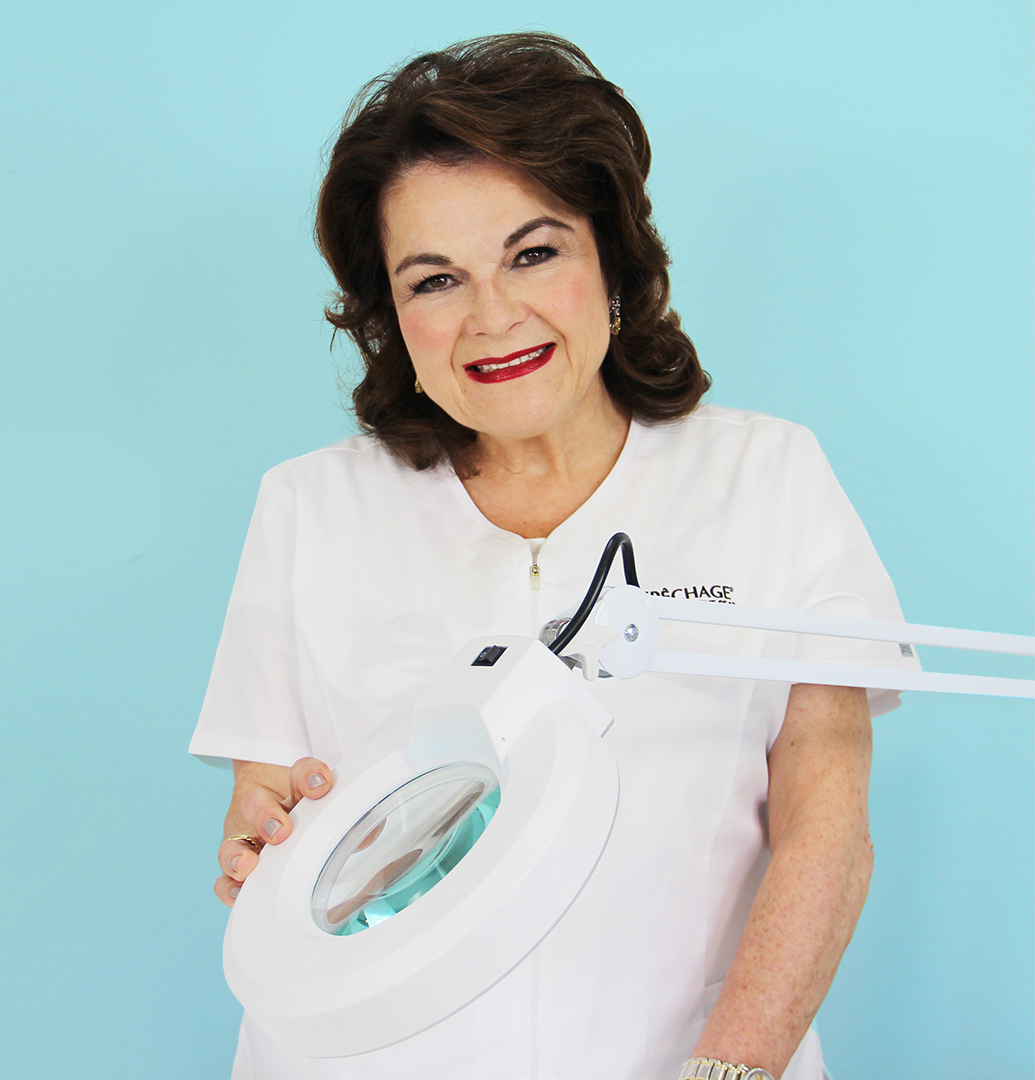
According to one of the study’s co-authors, Angela Noviello, Director of the Esthetic Division of Milano Estetica Cosmetic Surgery & Medical Spa, as well as Italian Director and European Coordinator for OTI Oncology Esthetics, oncology esthetics can have a multitude of benefits, including:
- Promoting relaxation
- Promoting blood circulation
- Promoting hydration
- Stimulating or relaxing the nervous system
- Promoting enhanced breathing
- Promoting sleep
- Pain reduction
- Reducing side effects of treatment such as nausea and loss of appetite
- Improving the quality of the skin
- Reducing anxiety and depression
- Promoting socialization
Types of Cancer Treatment and Their Side Effects
The first area of education involves understanding the various forms of cancer treatment. Treatment can be broadly divided into local, where treatment is directed at a specific part of the body and is often used when cancer is only present in that area.
Radiation therapy and surgery are both local treatments. Systemic treatment travels through the bloodstream to reach cancer cells throughout the body. Many chemotherapy drugs are systemic treatments that are absorbed by the body’s cells and tissues. Targeted therapy uses drugs to target specific molecules (such as proteins) on or inside cancer cells. By targeting these molecules, the drugs stop the growth and spread of cancer cells and limit harm to healthy cells.
Side effects of these treatments can include pain, swelling, scars from surgical procedures, skin discoloration, radiation dermatitis, erythema or reddening of the area, edema, partial loss of epidermal basal cells which can cause dryness, itching, scaling, flaking and peeling, dark circles, hyperpigmentation, crusting, blistering, fatigue, and hair loss.
Do No Harm
As with all services, the most important maxim is to do no harm to the client. When it comes to oncology patients, this is even more imperative since their bodies and immune systems have been severely compromised through treatment.

Oncology facial care training will not only review the kinds of treatment an oncology patient may be undergoing, but also cover important aspects of altering spa services to suit this client, and are covered in depth in text books such as Oncology Esthetics®, Morag Currin, (Oncology Training International, 2020.) With this, the esthetician will:
– Learn how and when to modify spa services during all phases – before, during and after – cancer treatment.
– Learn what ingredients to avoid, such as perfumes, parabens, silicones, DEA, TEA, Oxybenzone, glycols, alcohol, sulphates and triclosan. (For a full list of ingredients, see Oncology Esthetics.)
– Acquaint yourself with oncology specialists who will provide insights about beneficial services as well as methods and services that are prohibited.
– Learn how to properly approach to the client, including modifying voice and demeanor, to create gentle, calm and soothing atmosphere.
– Always pay attention to the clients comfort.
– Learn about proper sanitation, including use of antimicrobial products registered with the EPA as sterilizers.
– Understand how all of the spa and salon needs to be modified for proper sterilization, including proper cleaning of the front desk area, shelves, waiting room chairs, facial bed, trolley, chair counter tops, bathrooms (sink, toilette), towel dispenser, soap dispenser.
– Making sure all areas should be well ventilated.
– When possible, utilizing disposable implements and utensils such as sheets, spatulas, headbands, brushes and towels to avoid cross contamination.
– Wearing personal protective gear such as medical grade nitrile gloves, goggles, face mask and lab coat and learning proper removal of gloves and changing gloves upon completion of any procedure and prior touching of any clean surfaces
– Proper cleaning and storing of non-disposable implements in a dry sterilizer or autoclave.
– Understanding how small but important accommodations count in the facial room:
- Have a step stool to make it easy for them to get on the bed.
- Have a comfortable seating spot in case the client needs a minute to just sit and relax.
- Have a wig stand for those who need it.
– Be prepared to stop. Clients and survivors of cancer feel disconnected from their bodies.
The power of touch reveals stress, as well as hidden or contained feelings of neglect. Your response to the client’s emotional release, must be guided by the client, and if needed, treatment must be stopped.
Facial room or area set up:
Prepare your work station.
Make sure that your facial bed is draped and set correctly.
Make sure that your work table or trolley has all of the things that you will need during the facial procedure, including all of the products and supplies for the facials.
Make sure you have all of your instruments clean and saved in the sterilizer and your magnifying lamp is in place.
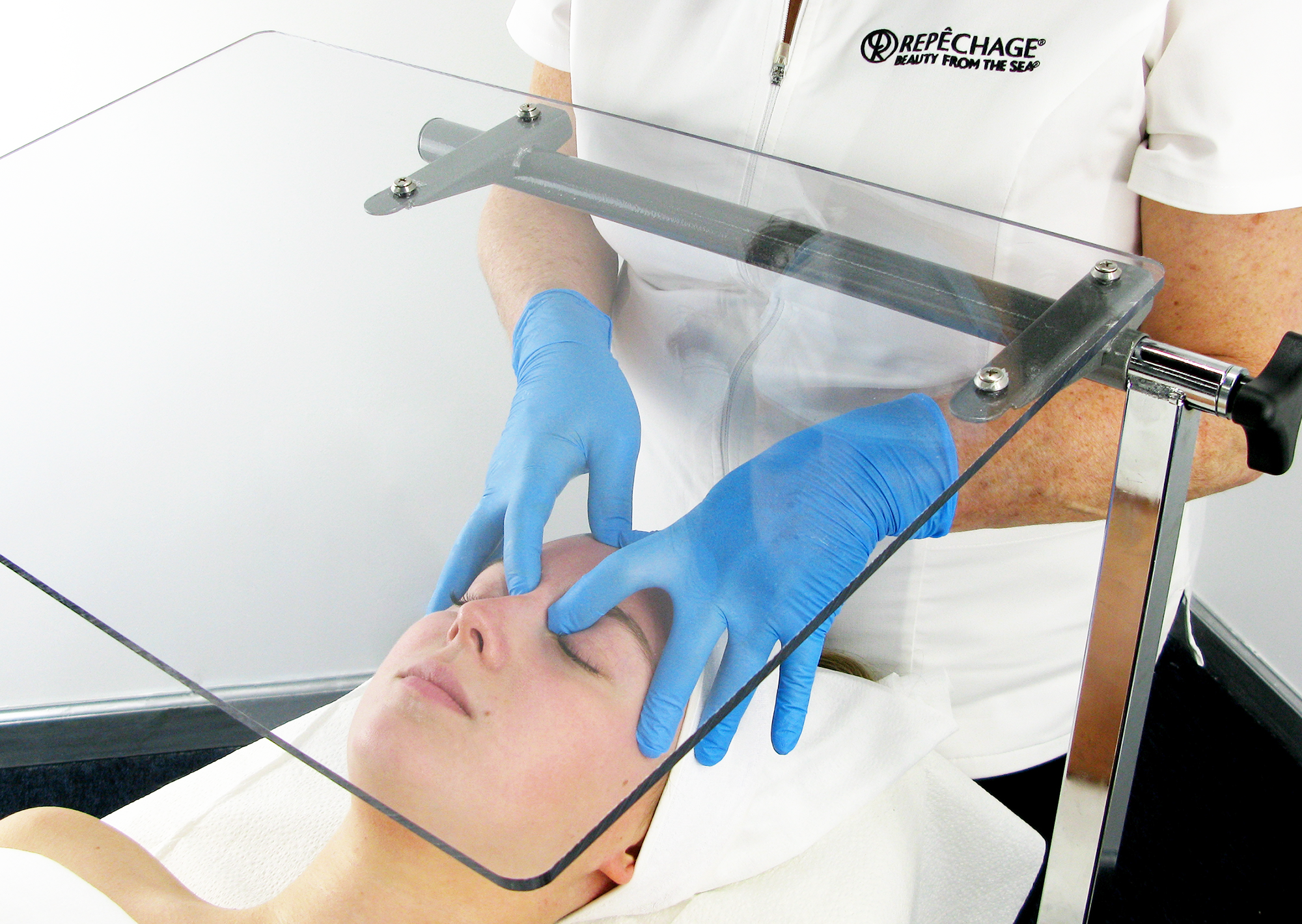
Hand Cleaning and Gloves:
Proper hand cleansing should be for at least 50 seconds. Take a soap cleanser that is anti-bacterial and wash hands thoroughly in warm water. Be vigorous in in this procedure, being sure to wash in between fingers, under fingernails and up to elbows. Rinse and dry thoroughly.
Put on nitrile gloves. Make sure they fit you well, and are not too small or too big. Press into the finger creases. After treatment, remove properly and discard them.
Facial Procedure:
Skin Analysis:
Once client is situated in the facial bed or chair, and has on a hair net, take a piece of cotton and place it over the eye area. Take your magnifying lamp and analyze the skin. Take a look at the condition, whether the skin is dry, compromised, oily, or whether the client is experiencing any kind of sensitivity.
Once you examine the skin correctly, remove the magnifying lamp, close it, put it away, remove the cotton, then come around and have a consultation with your client.
Consultation:
When we are dealing with oncology patients, there is no cookie-cutter treatment. Each client will require a different approach and different treatment. When you are doing a consultation, do not stand at the back of the clients head. Move forward and sit next to them. Always look at them and make sure they are looking at you. Make sure their ears are not blocked in any way so they can hear you properly and that they can see you. Very often, clients that are undergoing chemotherapy or radiation are super sensitive and might not be able to listen as attentively. It’s important to be calm, have a very calming demeanor and speak clearly and slowly. Always pay attention and use proper etiquette.
Cleansing:
To proceed with the facial treatment, for your client’s protection, as well as your own, please use a face mask and non-latex disposable nitrile gloves.
1. If the client has eye makeup, remove the eye makeup first.
2. Tear a piece of cotton*, wet it with water and squeeze out the excess. Moisten cotton with Opti-Cleanse™ Extra Gentle Non-Oily Eye Makeup Remover. Take the two pieces of cotton and place on the eye area. Leave one of the pads on as you work on the first eye.
*Please note: You will be using cotton in place of tissues through-out this facial procedure because cotton is softer and less irritating to compromised skin.
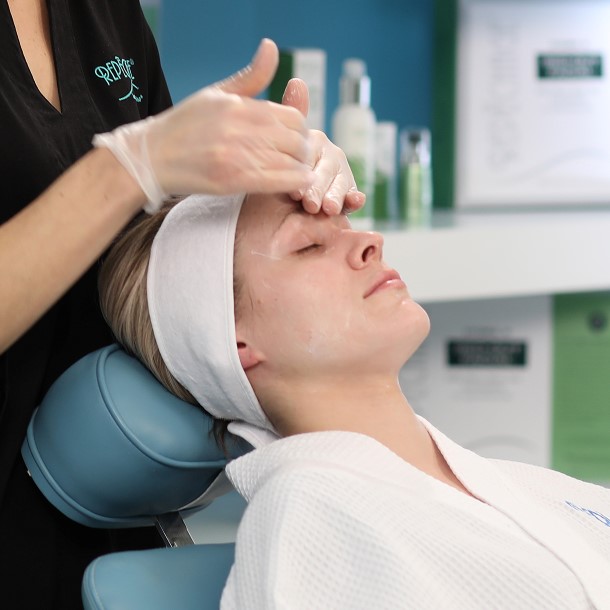
3. Gently remove the eye makeup, working downwards first, stroking through the eyelashes, and then wiping under the eye. Turn pad inside out for a clean surface then repeat, going downwards on the lashes and wiping under the eye area. Dispose of the cotton and move on to the other eye. Repeat the same the procedure on the other eye, moving downwards first then towards the nose. Turn cotton inside out for a clean surface and repeat.
4. Take a dry piece of cotton, and dry the area.
5. Use disposable brushes to apply the cleanser. Disposable brushes are a very hygienic alternative to fingers and help prevent cross contamination. These will also provide mild exfoliation. Use Hydra Dew Pure™ Gentle Foaming Cleanser. Apply it onto the skin in very gentle, upward, outward motions on the face and downwards on the neck. Never rub. Always finish all movements at the temples.
6. Take cotton moistened with lukewarm water to remove cleanser residue in upward/outward motions.
Dr. Lucas Pulverizer Championniere /Exfoliation
Use a Dr. Lucas Pulverizer Championniere instead of hot steam, which can irritate and inflame compromised skin. Combine distilled water with Repêchage® Hydra Dew Pure™ Facial Essence Mist in the Dr. Lucas Pulverizer Championniere to calm, soothe and hydrate the skin.
1. Provide a Dr. Lucas Pulverizer Championniere misting for about five minutes. Apply the spray from the back, not in front of the client, to prevent the spray from going up the client’s nose.
2. Use cotton to pat dry the skin. Again no rubbing. Be sure that you have no water dripping down the neck of your client.
3. If the client needs additional exfoliation, use Rapidex® Marine Exfoliator With Phyto-Marine Actives. It has a perfect pH, and a blend of mild, gentle and effective AHAs combined with seaweed and marine hydroxy acids. This exfoliant is premeasured and opened at the time of use with no cross contamination. Open the swab and swipe on the skin in gentle strokes all over the face. Once you swab it on, you may want to use a little fan to cool the skin down. Remove after five minutes with moistened cotton and water. You may use a water spray bottle, or repeat using the Dr. Lucas Pulverizer Championniere.
Please note: Always ask the client if they feel tingling from a scale of 1 to 10. Anything up to 6 is normal. If they are feeling tingling from 8 on up to 10, this is the time to remove the solution.
At this point, various forms of facial massage, including Effleurage, and facial massage utilizing the Repêchage® Kansa Wand and Repêchage® Silver Ball Massager, can be employed in the facial. These forms of treatments are outlined in detail by Oncology Training International in their Oncology Esthetics® text book available on pro.repechage.com for licensed professionals.
Sheet Mask and Repêchage® LED Radio Frequency and EMS Skin Tightening Machine
*IMPORTANT: Before proceeding with any spa treatment, you must have the client complete an intake form including current treatments, medications and side effects, and obtain confirmation from the client that his/her physician has approved the spa treatment to be administered. Carefully review the intake form to determine if any modifications are needed based on the information provided by the client. Some spa treatments, including, but not limited to, those that include a hand and/or foot massage or use of a cosmetic device may need to be modified. As an esthetician you must consider each client based on his/her specific condition and modify the spa treatments accordingly.
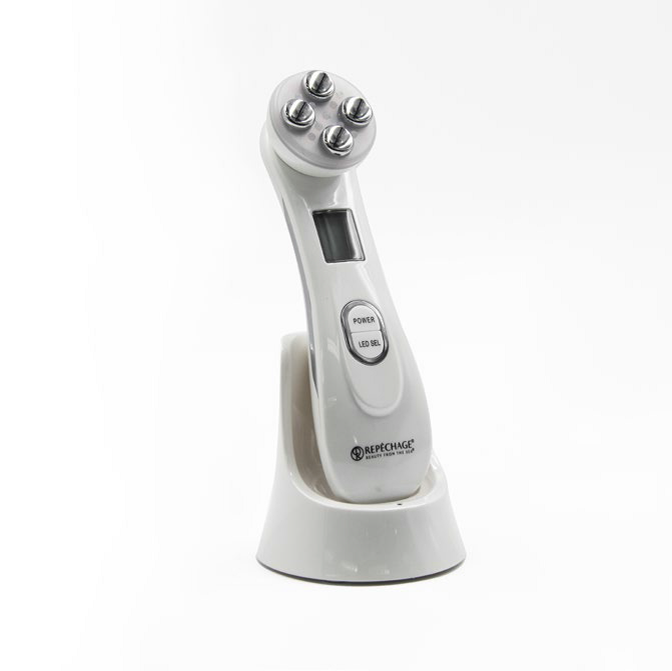
1. Take scissors from the sterilizer and cut open the Repêchage® Lamina Lift™ Mask, which contains calming, soothing and hydrating chestnut extracts, aloe, seaweed, and spirulina, extracts, and remove mask from inside of pouch.
2. Open the mask, apply to the face then remove the plastic backing and throw the backing away. Position mask to fit correctly. Place Repêchage® Eye Rescue Pads over the eyes. These contain Yerba Mate tea, which helps with the puffiness of the eye area.
3. Now to help with deep surface hydration and nourishing of the skin, use Repêchage® LED Radio Frequency and EMS Skin Tightening Machine on Red light setting, as well as gently radio frequency. Used over the sheet mask, this device helps with the penetration of the key ingredients into the surface layers of the skin while the sheet mask provides a barrier.
4. Starting at the chin, lightly press the device onto the mask in upwards and outwards circles, going up to the forehead and creating more circles then upwards on the opposite side of the face. Perform this for five minutes. (For cleaning directions, see end of protocol).
5. Use Repêchage® Essential Oil of Seaweed on the lips. Very often the client is experiencing extreme dryness on the lips. This is a pure essential oil of seaweed and Vitamin E. Or, Hydra Dew Pure™ Oil can be used as well.
Hand and Foot Massage
*IMPORTANT: Before proceeding with any spa treatment, you must have the client complete an intake form including current treatments, medications and side effects, and obtain confirmation from the client that his/her physician has approved the spa treatment to be administered. Carefully review the intake form to determine if any modifications are needed based on the information provided by the client. Some spa treatments, including, but not limited to, those that include a hand and/or foot massage or use of a cosmetic device may need to be modified. As an esthetician you must consider each client based on his/her specific condition and modify the spa treatments accordingly.

During this time while the mask is on, you may offer the client a wonderful hand massage, foot massage or a scalp massage. This will provide the client with a very relaxing, calming and healing treatment. Think of your hands as healing hands.
1. First, cleanse the hands with cotton moistened with luke-warm water.
2. Apply Repêchage® Sea Spa Hand Cream and massage into the hands, gently rubbing into the hands and outwards to the fingers. Stroke down from the wrist, then gently tilt the hand up, clasp the fingers and rotate the hand at the wrists. Repeat on the other side.
3. Cleanse feet with moistened cotton. Apply Repêchage® Sea Spa Foot Cream in upwards strokes towards the ankles in gentle effleurage movements. Work cream gently into the toes then gently press upwards from toes to ankles along the center of the top of the foot. Circle the ankle bones lightly, and finish with light strokes. Cover with a dry towel, and repeat on other foot.
Mask Removal
1. After 10 to 15 minutes, remove the mask. Gently peel the mask off the skin, leaving the residue.
2. Take the Repêchage® Hydra Dew Pure™ Facial Essence Mist and spray the face.
3. Use dry cotton to dry the face, patting gently. When you work with one hand, rest the other on the top of the forehead.
4. Once treatment is over, apply a barrier cream that combines zinc, titanium and seaweed such as Repêchage® Mineral Face Shield® which is also fragrance and water free.
Makeup Application:
Use makeup such as Repêchage® Perfect Skin Mineral Makeup which contains seaweed extracts that contains vitamins, minerals, amino acids and antioxidants.
Use Repêchage® Perfect Skin Perfecting Concealer under the eye area to cover the dark circles.
Use Repêchage® Perfect Skin Liquid Foundation on a disposable sponge. Apply Perfect Skin Natural Finish Pressed Powder directly on the sponge and apply to nose, center of the chin, forehead. Finish with a coat of Perfect Skin Conditioning Lip Gloss applied with a disposable brush.
Post-Treatment Sanitation:
Wash Repêchage® Silver Ball Massagers with anti-bacterial soap and warm water, then immerse in small cups filled with alcohol for seven minutes. Remove, dry and put in dry sterilizer.
If you have any further questions about this post, please leave them in the comments.
**products listed in this blog post are not intended to treat, diagnose, cure or prevent any disease.
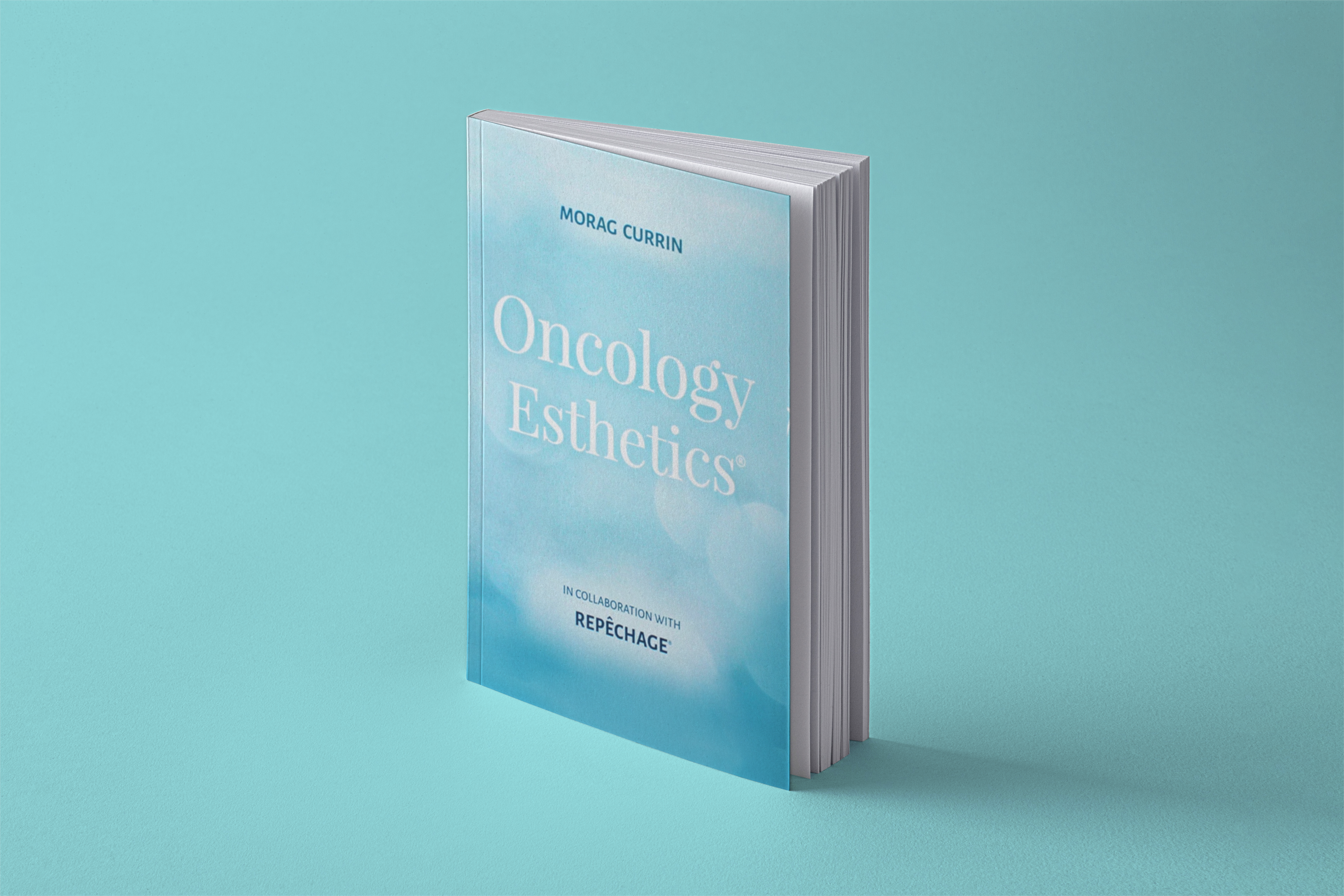

I am an esthetician who has been diagnosed with stomach cancer. After I kick cancer in the booty my goal is to get certified in oncology esthetics. Cancer patients want to look good too!
In the meantime, can you give me a list of products that would be good for me.
Thank you!!
Thank you for your comment and for sharing. We are so glad to hear you are doing well. Please refer to Oncology Esthetics (Morag Currin 2020) in collaboration with repechage that you may find at pro.repechage.com or by emailing info@repechage.com